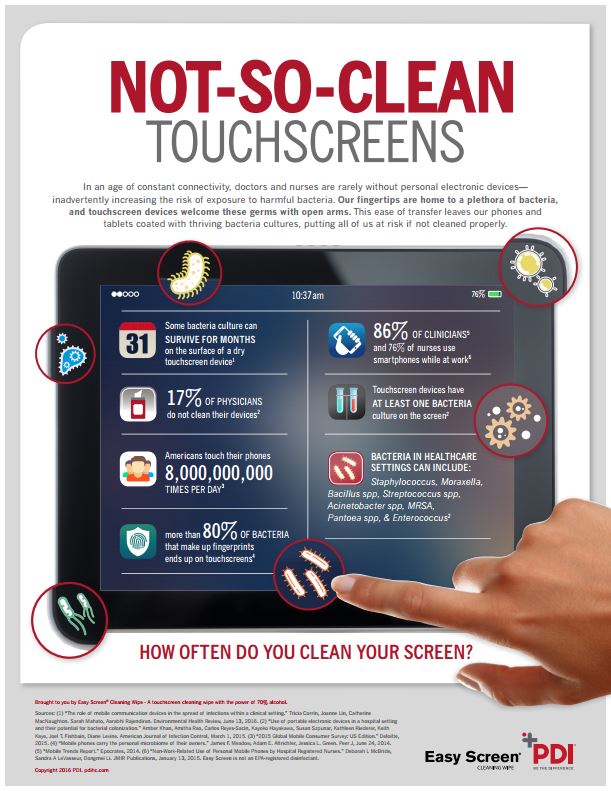From cell phones and tablets to airport kiosks and restaurant menus, touchscreens are everywhere, and they're all covered in germs.

Cleaning and Health Tips for Touchscreens
Improvements in technology combined with the need for more accurate record keeping, waste reduction, and simple task automation, has led to the rise of touchscreens in nearly every facet of our lives.
The sad and disgusting truth is that nearly every one of these devices is covered in germs that can make you and everyone you come into contact with sick.
Not just a little sick, either.
A 2009 study published in the Annals of Clinical Microbiology and Antimicrobials found that;
[...] 94.5% of phones demonstrated evidence of bacterial contamination with different types of bacteria.
The gram-negative strains were isolated from mobile phones of 31.3% and the ceftazidime-resistant strains from the hands were 39.5%. S. aureus strains isolated from mobile phones of 52% and those strains isolated from hands of 37.7% were methicillin resistant.
Are we aware how contaminated our mobile phones with nosocomial pathogens?
A recent expose conducted and broadcasted by CBS3 in Philadelphia randomly tested three kiosk screens at popular restaurant chains and sent the swabs in for testing.
As expected, their findings were disturbing.
Only one of the three screens came back clean.
The second touch screen menu turned up with fungus, both Penicillium and yeast species, which can cause allergic reactions in sensitive individuals.
The third test came back with a large population of pantoea agglomerans, a bacteria that’s common to plants and feces.
That third kiosk also contained an extremely large amount of Acinetobacter species, a bacteria that can prove dangerous to hospitalized patients.
The Swab Test: Amount Of Bacteria On Touchscreens May Surprise You
Unfortunately, the tests and results do not stop there.
ABC7 in Washington D.C. found 2400 Colony Forming Units (CFUs) per swab on a random touchscreen checkout device located at a Giant grocery store.
Most concerning, the news organization also discovered Burkholderia Cepacia and Citrobacter Freundii, bacteria known to cause serious illness and infection, on an 'ATM, a RedBox movie rental station, and a ticket kiosk at the Regal movie theater in Gallery Place.'
Source:
How can something like this be possible in such a technologically advanced society?
Simple.
Poor hand-hygiene and an utter disregard for the cleaning and disinfection requirements necessary to sanitize these heavily used, high-contact surfaces.
Combatting the Rise of Germs Transferred via Touchscreens
Nearly every study published has shown the transfer rate of germs and bacteria from a touchscreen, especially smartphones, to our hands at a rate of approximately 30 percent.
It's probably safe to conclude that most people don't wash their hands immediately after using an ATM or checking out of a grocery store, let alone after using phones.
The germs present on the touchscreen surfaces are then transferred from our hands to everything that we touch, like our eyes and nose, or our food and loved ones, resulting in further spread of the germs, and possible infection and serious illness.
The challenge is most daunting in schools, hospitals, and restaurants where we are either most vulnerable or at the highest risk for ingestion.
The responsibility for addressing this challenge does not rest solely with the establishments we patron.
Personal hand-hygiene, or the lack thereof, is a significant determining factor in our contribution to the spread of these germs.
To combat this, businesses need to:
- Implement standardized disinfection policies that acknowledge and address the presence and danger of germs on these increasingly high-contact surfaces.
- Utilize disinfection strategies with products that have demonstrated a proven residual disinfection capability.
- Schedule regular maintenance wipe downs of devices during operational hours.
- Supply convenient sanitation stations for consumers, and;
- Consider switching out current technologies for products that possess antimicrobial properties, such as screen covers for smartphones.
Each of us individually should;
- Make sure we wash our hands thoroughly before we eat and after using the restroom.
- Use hand sanitizer after engaging with public touchscreens, especially in airports, restaurants, hospitals, and schools, and;
- Wipe down our personal devices with a certified green sanitation wipe on a regular basis.
References & Resources
- Touchy feely restaurant screens covered with creepy crawlies
- Touchscreen technology can limit the spread of bacteria
- Touch Screens, Cell Phones Can Make You Sick
- How your next phone could stop the spread of infection
- Your Mobile Phone is Dirtier Than You Think
- Infection Prevention: Touchscreens are contaminated
Takeaway
The simple but hard truth of the matter is that the way we as consumers, and businesses in general, choose to engage with these technologies has likely lead to the expensive hospitalization and preventable death of someone we've likely never met.
Businesses typically have neither the time or resources to address the cleaning and disinfection challenges associated with heavy-use touch screens, underscoring the benefits of outsourcing to an experienced custodial vendor.
Common cleaning and disinfection chemicals, such as bleach, ammonia, and alcohol can damage or etch touchscreen technologies, which are incredibly expensive to replace, underscoring the need for a greener, more effective approach, such as microfiber and antimicrobial protective film overlays.
If you would like to learn more about the challenges associated with touchscreen cleaning and disinfection, or the benefits of outsourcing your janitorial needs to a local custodial vendor–contact us today for a free quote!
In Bakersfield CA, call (661) 4373253
In Fresno CA, call (559) 206-1059
In Valencia CA, or Santa Clarita CA, call (661) 437-3253



You must be logged in to post a comment.